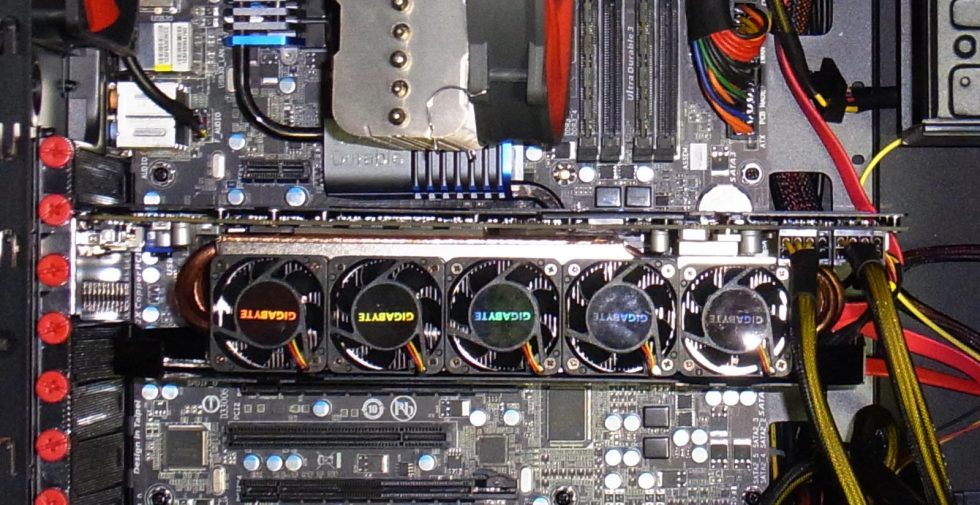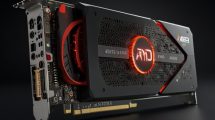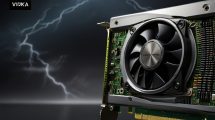Preface and measurement method
Before we take a closer look at different ranges and scenarios, we first fixed the most important speeds via settings and recorded them for direct comparison in picture and sound. The recordings were made at a distance of 50 cm, as was the measurement of the sound level. This time, the audio track comes directly from the device for the level measurements. We mixed the respective video and sound after each run, as well as synchronized both appropriately.
| VGA testbench (open structure) | |
|---|---|
| Processor | Core i7 2600K @4.5 GHz |
| Cooler | Prolimetech Supermega + Noiseblocker Multiframe |
| Memory | 4 x 4 GB Kingston HyperX 1600 |
| Mainboard | Gigabyte Z68X UD7-B3 |
| Operating system and drivers | Windows 7 Ultimate x64 Catalyst 12.6 WHQL |
| Test software | Furmark, OCCT |
30% Fan speed
After manually changing the fan control profile, we use this value as the initial value for room temperatures up to 28°C, since the original value of 40% is too high from our point of view. But more about that later. First of all, we noticed that the acoustic performance in load-free operation was more discreet than initially feared. Only the somewhat metallic, buzzing motor noise of the 5 fans disturbs the acceptable overall picture, especially since there should be no noise reduction due to the requirement of a side panel opening. This is a noise that the proud owner will probably have to live with. We spared the video with 40% because such high idle speeds are simply pointless. On average, you can comfortably stay below 36 dB(A), at 40% it would be already plenty of 38 dB(A)
50% fan speed
After changing the fan profile, the speed range between 45 and 55% is exactly the speed window that we could determine later during the measurements from the Gamig scenarios to the stress test. While you can still stay below the 50% mark during gaming, higher rates of up to 47 dB(A) occur during the stress test and GPGPU applications that demand more computing power. The normal gaming level should not exceed 45 dB(A), which is still an acceptable value. Axilal fan cards like an Asus 7970 DirectCUII are much quieter here, but have a much more negative impact on the internal temperatures, while the Windforce 5X, in contrast, was even able to cool things down. The CPU did not show any measurable temperature increases after several hours of operation and remained on the same level as in comparison measurements with a very frugal Radeon HD 6570.
75% Fan speed
Now it gets really loud and for the first time we clearly suffer from the 5 very small fans, which are acoustically very impressive. We measured just under 60 dB(A) , which is about as much as the Radeon HD 7970 GHz Edition also achieved in Furmark in our tests. However, the GPU temperatures are then a record-breaking 65°C in the continuous stress test in the open case and 68°C in the closed case (GHz Edition 90°C!), which led us to use the manually modified fan profile described in the next chapter throughout. You simply don’t need that much reserve if it is so extremely at the expense of the noise, and it repeats the same little game as with the Gigabyte GTX 680 Windforce 3X, where the fan profile was once again adjusted in a new BIOS revision after our objections.
100% Fan speed
This value can never be reached in fact, unless you set it manually – for whatever reason. The sound level is now an ear-catching 62.9 dB(A) and is unacceptable to anyone. Whereby this value is really only theoretical. But you should already know what works.
Interim summary
The card is quieter than one might first assume, but not really quiet. The basic noise at idle is generated by the high number of fans, but is bearable in moderation. The speeds in the medium and higher load range around 50% produce a just acceptable sound level that remains well below 50 dB(A). This is especially true when you use the huge cooling reserves to further lower the sound level. This is exactly what we will now test in great detail in the next chapter.


































9 Antworten
Kommentar
Lade neue Kommentare
Veteran
1
Veteran
Veteran
Urgestein
Mitglied
Veteran
Urgestein
Mitglied
Alle Kommentare lesen unter igor´sLAB Community →